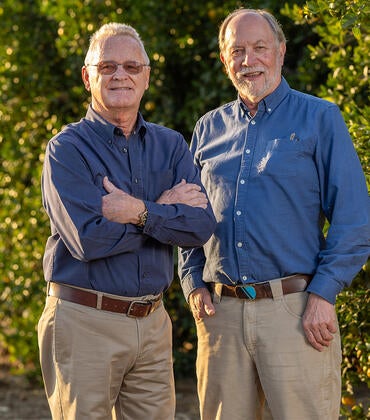FarmSense, a startup co-founded by Bourns College of Engineering computer science professor Eamonn Keogh, Shailendra Singh, who received his PhD in computer science from UC Riverside, and Agenor Mafra-Neto, founder of ISCA Technologies in Riverside, was one of 30 startups selected for the Alliance for SoCal Innovation SoCal First Look Showcase at UCLA in June.
The young company has also been selected by MassChallenge accelerator to help scale up FarmSense’s production of FlightSensor, a pest monitoring device, for field trials and commercial sales. FarmSense is a resident of ExCITE, a startup accelerator partnership between UC Riverside, the City of Riverside, and Riverside County.
FlightSensor is a real-time, cloud-based insect monitoring platform which detects, classifies, and quantifies insects. When this information is integrated with crop and environmental information, farmers know where both beneficial and pest insects are in space and time. They can manage pesticides more judiciously, saving money and reducing crop loss.
If widely adopted, FarmSense could reduce or prevent pesticide resistance in insect populations. It can also monitor disease in human and animal populations and reduce stress in farm animals caused by insects. The technology has biosecurity applications— it can help governments detect and trigger early interventions to prevent invasive insects from naturalizing.
Current insect monitoring techniques are labor-intensive, with varying levels of sensitivity and accuracy. The most common technique involves visual inspection of insects stuck to a strip of paper, which can take hours or days and requires magnification and possibly the services of a professional entomologist.
“The farmers have to sit there with a microscope and clicker,” said Keogh. “They’re busy, hardworking people, so they don’t bother. They just spray the pesticide. With better information, they can spray less.”
FlightSensor consists of a battery-operated sensor and transmitter integrated with insect traps, already widely in use. The sensor detects the species based on wingbeat frequency and sends that information, along with the time and location, to an app on the farmer’s phone or computer.
Early field tests revealed surprising complications.
“When we tested it in Hawaii,” Keogh recounted, “the sensors kept breaking. It turns out that the trapped insects attracted geckos, which got into the traps and broke the sensors.”
Attaching the traps to aluminum poles that the geckos couldn’t climb solved the problem.
Remaining challenges include production on a commercial scale, which MassChallenge will help solve, and more fully understanding farming culture. Two of the global leaders in agricultural technology have partnered on field trials in the U.S. to evaluate the product and learn more about the FlightSensor’s field performance and utility.



